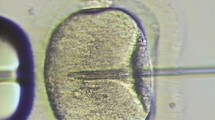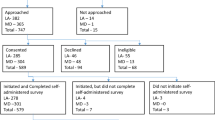Abstract
In the near future the availability of non-invasive prenatal diagnosis (NIPD) for single gene disorders will change the prenatal diagnosis options available to couples who are carriers of conditions such as cystic fibrosis, sickle cell disorder and thalassaemia. Client opinions about NIPD are needed to inform the implementation of NIPD for single gene disorders. This qualitative study used two focus groups (n = 12) and one-to-one interviews (n = 16) with carriers and support group representatives of sickle cell disease, thalassaemia and cystic fibrosis. Discussions were digitally recorded, transcribed verbatim and analysed using thematic analysis. Opinions about NIPD were very positive and participants valued the opportunity to have safe and early testing. Uptake of prenatal testing is likely to increase as women who had previously declined invasive testing expressed interest in having NIPD. Participant concerns about NIPD centred on the need for accuracy to be high to be used for subsequent decision making about termination of pregnancy. Participants also raised concerns that less thought may be given to having a blood test compared to an invasive test and that the perceived ease of a blood test may bring increased pressure to have testing. Participants thought NIPD should be offered through existing specialist services to ensure appropriate genetic counseling and support. Maintaining all testing options is important as some people may prefer invasive testing over NIPD if invasive testing was more accurate or if invasive testing could give information about other conditions such as Down syndrome.
Similar content being viewed by others
References
Barrett, A. N., McDonnell, T. C., Chan, K. C., & Chitty, L. S. (2012). Digital PCR analysis of maternal plasma for noninvasive detection of sickle cell anemia. Clinical Chemistry, 58(6), 1026–1032.
Braun, V., & Clarke, V. (2006). Using thematic analysis in psychology. Qualitative Research in Psychology, 3, 77–101.
Bustamante-Aragones, A., Rodriguez de Alba, M., Perlado, S., Trujillo-Tiebas, M. J., Arranz, J. P., Diaz-Recasens, J., et al. (2012). Non-invasive prenatal diagnosis of single-gene disorders from maternal blood. Gene, 504(1), 144–149.
Chitty, L. S., Griffin, D. R., Meaney, C., Barrett, A., Khalil, A., Pajkrt, E., et al. (2011). New aids for the non-invasive prenatal diagnosis of achondroplasia: dysmorphic features, charts of fetal size and molecular confirmation using cell-free fetal DNA in maternal plasma. Ultrasound in Obstetrics and Gynecology, 37(3), 283–289.
Chitty, L. S., Khalil, A., Barrett, A. N., Pajkrt, E., Griffin, D. R., & Cole, T. J. (2013). Safe, accurate, prenatal diagnosis of thanatophoric dysplasia using ultrasound and free fetal DNA. Prenatal Diagnosis, 33(5), 416–423.
Clinical Molecular Genetics Society (CMGS) (2013). Audit 2011–2012. Available from http://www.cmgs.org/CMGS%20audit/2012%20audit/CMGSAudit11_12_FINAL.pdf, Accessed May 2013.
de Jong, A., Dondorp, W. J., de Die-Smulders, C. E., Frints, S. G., & de Wert, G. M. (2010). Non-invasive prenatal testing: ethical issues explored. European Journal of Human Genetics, 18(3), 272–277.
de Jong, A., Dondorp, W. J., Frints, S. G., de Die-Smulders, C. E., & de Wert, G. M. (2011). Advances in prenatal screening: the ethical dimension. Nature Reviews Genetics, 12(9), 657–663.
Deans, Z., & Newson, A. J. (2011). Should non-invasiveness change informed consent procedures for prenatal diagnosis? Health Care Analysis, 19(2), 122–132.
Deans, Z., Hill, M., Chitty, L. S., & Lewis, C. (2013). Non-invasive prenatal testing for single gene disorders: exploring the ethics. European Journal of Human Genetics, 21(7), 713–718.
Dormandy, E., Gulliford, M., Bryan, S., Roberts, T. E., Calnan, M., Atkin, K., et al. (2010). Effectiveness of earlier antenatal screening for sickle cell disease and thalassaemia in primary care: cluster randomised trial. BMJ, 341, c5132.
D'Souza, E., Sawant, P. M., Nadkarni, A. H., Gorakshakar, A., Ghosh, K., & Colah, R. B. (2013). Detection of fetal mutations causing hemoglobinopathies by non-invasive prenatal diagnosis from maternal plasma. Journal of Postgraduate Medicine, 59(1), 15–20.
Hall, A., Bostanci, A., & Wright, C. F. (2010). Non-invasive prenatal diagnosis using cell-free fetal DNA technology: applications and implications. Public Health Genomics, 13(4), 246–255.
Hill, M., Finning, K., Martin, P., Hogg, J., Meaney, C., Norbury, G., et al. (2011). Non-invasive prenatal determination of fetal sex: translating research into clinical practice. Clinical Genetics, 80(1), 68–75.
Hill, M., Compton, C., Lewis, C., Skirton, H., & Chitty, L. S. (2012). Determination of foetal sex in pregnancies at risk of haemophilia: a qualitative study exploring the clinical practices and attitudes of health professionals in the United Kingdom. Haemophilia, 18(4), 575–583.
Hill, M., Karunaratna, M., Lewis, C., Forya, F., & Chitty, L. (2013). Views and preferences for the implementation of non-invasive prenatal diagnosis for single gene disorders from health professionals in the United Kingdom. American Journal of Medical Genetics Part A, 161A(7), 1612–1618.
Hodgson, J., & Spriggs, M. (2005). A practical account of autonomy: why genetic counseling is especially well suited to the facilitation of informed autonomous decision making. Journal of Genetic Counseling, 14(2), 89–97.
Kelly, S. E., & Farrimond, H. R. (2012). Non-invasive preantal genetic testing: A study of public attitudes. Public Health Genomics, 15(2), 73–81.
Kitzinger, J. (2006). Focus groups qualitative research in health care (3rd ed.). BMJ Books: C. Pope and N. Mays. London.
Lench, N., Barrett, A., Fielding, S., McKay, F., Hill, M., Jenkins, L., et al. (2013). The clinical implementation of non-invasive prenatal diagnosis for single gene disorders: challenges and progress made. Prenatal Diagnosis, 33(3), 555–562.
Lerman, C., Croyle, R. T., Tercyak, K. P., & Hamann, H. (2002). Genetic testing: psychological aspects and implications. Journal of Consulting and Clinical Psychology, 70(3), 784–797.
Lewis, C., Hill, M., Skirton, H., & Chitty, L. S. (2012a). Fetal sex determination using cell-free fetal DNA: service users’ experiences of and preferences for service delivery. Prenatal Diagnosis, 32(8), 735–741.
Lewis, C., Hill, M., Skirton, H., & Chitty, L. S. (2012b). Non-invasive prenatal diagnosis for fetal sex determination: benefits and disadvantages from the service users’ perspective. European Journal of Human Genetics, 20(11), 1127–1133.
Lewis, C., Hill, M., Chitty, L. S. (2014). Non-invasive prenatal diagnosis for single gene disorders: experience of patients. Clinical Genetics, 85(4), 336–342.
Lo, Y., Chan, K., Sun, H., Chen, E., Jiang, P., Lun, F., et al. (2010). Maternal plasma DNA sequencing reveals the genome-wide genetic and mutational profile of the fetus. Science Translational Medicine, 2(61), 61ra91.
Lun, F. M., Tsui, N. B., Chan, K. C., Leung, T. Y., Lau, T. K., Charoenkwan, P., et al. (2008). Noninvasive prenatal diagnosis of monogenic diseases by digital size selection and relative mutation dosage on DNA in maternal plasma. Proceedings of the National Academy of Sciences of the United States of America, 105(50), 19920–19925.
Michie, S., Smith, J. A., Senior, V., & Marteau, T. M. (2003). Understanding why negative genetic test results sometimes fail to reassure. American Journal of Medical Genetics Part A, 119A(3), 340–347.
Pergament, E., & Pergament, D. (2012). Reproductive decisions after fetal genetic counselling. Best Practice and Research Clinical Obstetrics and Gynaecology, 26(5), 517–529.
Ropka, M. E., Wenzel, J., Phillips, E. K., Siadaty, M., & Philbrick, J. T. (2006). Uptake rates for breast cancer genetic testing: a systematic review. Cancer Epidemiology, Biomarkers and Prevention, 15(5), 840–855.
Sanderson, S. C., O’Neill, S. C., Bastian, L. A., Bepler, G., & McBride, C. M. (2010). What can interest tell us about uptake of genetic testing? Intention and behavior amongst smokers related to patients with lung cancer. Public Health Genomics, 13(2), 116–124.
Sayres, L. C., Allyse, M., Norton, M. E., & Cho, M. K. (2011). Cell-free fetal DNA testing: a pilot study of obstetric healthcare provider attitudes toward clinical implementation. Prenatal Diagnosis, 31(11), 1070–1076.
Sayres, L. C., Allyse, M., & Cho, M. K. (2012). Integrating stakeholder perspectives into the translation of cell-free fetal DNA testing for aneuploidy. Genome Medicine, 4(6), 49.
Skirton, H., & Patch, C. (2013). Factors affecting the clinical use of non-invasive prenatal testing: a mixed methods systematic review. Prenatal Diagnosis, 33(6), 532–541.
Tabor, A., & Alfirevic, Z. (2010). Update on procedure-related risks for prenatal diagnosis techniques. Fetal Diagnosis and Therapy, 27(1), 1–7.
Tischler, R., Hudgins, L., Blumenfeld, Y. J., Greely, H. T., & Ormond, K. E. (2011). Noninvasive prenatal diagnosis: pregnant women’s interest and expected uptake. Prenatal Diagnosis, 31(13), 1292–1299.
Yotsumoto, J., Sekizawa, A., Koide, K., Purwosunu, Y., Ichizuka, K., Matsuoka, R., et al. (2012). Attitudes toward non-invasive prenatal diagnosis among pregnant women and health professionals in Japan. Prenatal Diagnosis, 32(7), 674–679.
Acknowledgments
We are grateful to everyone who was interviewed or took part in a focus group as part of this study. We thank Dagmar Tapon and Tina Prendeville at Queen Charlotte’s & Chelsea Hospital, London, Bernadette Farren at Great Ormond Street Hospital NHS Foundation Trust and Sahar Mansour, Eleanor Lindahl and Yvonne Muwalo at St George’s Healthcare Trust for their help with recruitment. This manuscript presents independent research funded by the National Institute for Health Research (NIHR) under the Programme Grants for Applied Research programme (RP-PG-0707-10107) (the “RAPID” project) and the Central and East London NIHR Comprehensive Local Research Network. LSC is partially funded the Great Ormond Street Hospital Children’s Charity and the NIHR Biomedical Research Centre at Great Ormond Street Hospital. The views expressed are those of the authors and not necessarily those of the NHS, the NIHR or the Department of Health.
Conflict of Interest
Melissa Hill, Cecilia Compton, Madhavi Karunaratna, Celine Lewis and Lyn S Chitty declare that they have no conflict of interest.
Informed Consent
All procedures followed were in accordance with the ethical standards of the responsible committee on human experimentation (institutional and national) and with the Helsinki Declaration of 1975, as revised in 2000. Informed consent was obtained from all patients for being included in the study.
Human and Animal Rights
No animal or human studies were carried out by the authors for this article.
Author information
Authors and Affiliations
Corresponding author
Rights and permissions
About this article
Cite this article
Hill, M., Compton, C., Karunaratna, M. et al. Client Views and Attitudes to Non-Invasive Prenatal Diagnosis for Sickle Cell Disease, Thalassaemia and Cystic Fibrosis. J Genet Counsel 23, 1012–1021 (2014). https://doi.org/10.1007/s10897-014-9725-4
Received:
Accepted:
Published:
Issue Date:
DOI: https://doi.org/10.1007/s10897-014-9725-4




